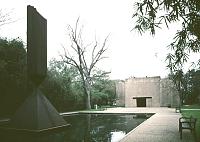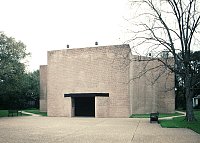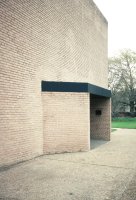

| The building was originally commissioned by Dominique and John de Menil as part of Philip Johnson's design for the University of St. Thomas campus, although they later discontinued their association with that university. The interior of the chapel contains fourteen paintings commissioned from Mark Rothko who collaborated with Johnson in the design of the chapel. | ||
| The plan was originally for a square building, but with Rothko's participation, it evolved to an octagonal shape. Johnson's plan also included a single-story building with a pyramidal roof (slightly truncated). It would have been sited at the end of the University of St. Thomas mall as well, a site now occupied by the Johnson-designed Chapel of St. Basil. After doing a number of revised plans, Johnson withdrew from the project, although he later served as a consultant. Eventually, he "designed the main entrance to the chapel, including the windows that bring daylight in to the vestibule; he oriented the chapel on the site; and he designed the reflecting pool for Barnett Newman's sculpture, Broken Obelisk" (Barnes 86). |  |
|

|

|
The octagonal chapel is windowless and is located in a park with several sculptures from the Menil Collection, including Barnett Newman's sculpture Broken Obelisk, which is situated in a reflecting pool opposite the entrance of the chapel. This 26 foot high work, dated 1968, it is dedicated to the memory of Martin Luther King, Jr., who was assassinated in that year. |
 Click here to return to index of art historical sites.
Click here to return to index of art historical sites.
 Click here to return to index of artists and architects.
Click here to return to index of artists and architects.
 Click here to return to chronological index.
Click here to return to chronological index.
 Click here to see the home page of Bluffton University.
Click here to see the home page of Bluffton University.
